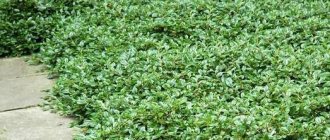Loading…
Loading…
To prepare the well-known Caesar, great culinary gurus use romaine lettuce. Growing romaine lettuce poses some challenges when it comes to seed preparation. It is also important for the farmer to choose fertile, nutritious soil for sowing. Having done everything correctly, the gardener will receive a wonderful harvest.
However, many gardeners confuse this crop with young Chinese cabbage. Therefore, it is important to know what romaine lettuce looks like. The plant is an intermediate variety between the leaf and cabbage varieties. Like Chinese cabbage, the fleshy leaves of romaine lettuce are collected in a rosette. Some varieties resemble horseradish or spinach in appearance. The root part of the bunch has an almost white tint, and the upper part is dark green. These elongated leaf blades are distinguished by pronounced veins.
The taste of romaine lettuce leaves is much sweeter, juicier and more pleasant than other varieties. It does not give off bitterness, but on the contrary, pleases with a delicate nutty aftertaste. These subtle notes of sweetness blend delicately with the overall composition of the dish rather than overwhelm it.
a brief description of
Only young lettuce leaves are used in cooking. They contain a lot of fiber, as well as vitamins A, K and C. In addition, they contain macro- and microelements necessary for the proper functioning of the body.
Initially, when lettuce was first discovered, which was over 5,000 years ago, romaine was used exclusively in folk medicine. Later they were able to evaluate it not only for its usefulness, but also for its taste.
Romaine lettuce can be classified as either a head or a leaf plant, as it is a variety of lettuce. The calorie content of Romano per 100 grams is 17 kcal.
What does it look like?
The head of lettuce has an oblong-elongated shape and is slightly loose. The leaves are long and dense. The color is rich or pale green. The shade is darker along the edges of the leaves, lighter in the center. The base of the head of cabbage is light, almost white.
Lettuce weight
The weight of one head of romaine varies from 300 to 600 grams. © https://ydoo.info/product/salat-romano.html The weight of one leaf is approximately 8-12 grams.
Taste
Young leaves of romaine lettuce have a crispy texture, juicy taste, with a subtle nutty flavor. The more lettuce is not removed from the garden, the denser the stem becomes, which is why it cannot be added to dishes.
Storage rules
Supermarkets most often sell the leaves in pots; in this form, the salad can be stored for quite a long time, up to 3 weeks .
If you store it in the refrigerator, it is better to lightly sprinkle it with water and wrap it with a napkin. Use the bottom shelf of the refrigerator for storage. Make sure that the leaves do not rot. Shelf life inside the refrigerator is 3-5 days .
If you buy a plant in a pot, you can store it for up to 3 weeks.
Some housewives freeze greens and use them for subsequent preparation of soups and cocktails. Freeze whole bunches or chop by hand. When frozen, the salad loses its attractiveness. However, when defrosted, the taste remains. You can freeze in ice cube trays by first filling the greens with water.
To make the leaves crunchy when serving, soak them in ice water for 30 minutes before cooking.
Difference between romaine and other types of lettuce
Externally, different types of salads are often similar to each other. Romano is especially like an iceberg. The difference between salads is in the details.
Iceberg
Despite their external similarity, salads have different chemical compositions and tastes. Romano is juicy, with a slight tart taste and a hint of spice. Iceberg is crispier and tastes more like white cabbage. In addition, romaine lettuce is more nutritious than iceberg lettuce.
Romaine
They are the same salad, only "romano" is the more common name.
Harvest
The process takes place over different periods of time, because the degree of ripening varies. If the core is firm when pressed, the salad is ripe.
10-15 days before harvesting, “bleaching” is carried out, the leaves are tied close to the head of cabbage, this will relieve Romaine of bitterness.
Another method helps obtain seed material, but in this case, the lettuce itself is unsuitable for food. They begin collecting after the appearance of a brown tint on the leaves and the fly. Thresh the seed, dry it, and remove debris through a sieve.
How to choose?
If possible, roman lettuce should be purchased as a whole head of lettuce, and not as individual leaves, since selling by the sheet may indicate some defects in the head of lettuce.
The leaves should be dense, without mechanical damage and signs of wilting. The color should be uniform, the shade varies from light to dark green. There should be no streaks, inclusions or yellow spots on the surface of the sheet.
A fresher lettuce is one that is sold in special small containers with soil, as it does not spoil as quickly.
Whitening
To form a dense head and improve the taste of salad greens, romaine is bleached. It's done like this: leaves? reaching a height of 20–30 cm? lift and tie their tops with thin elastic twine. The procedure is carried out in stages, tying together several leaves at a time with a break of 7–10 days. After bleaching, Roman lettuce becomes especially tasty and tender; the tight, compact heads are distinguished by good keeping quality and, at a temperature of about +4 °C, retain their commercial quality for 2–3 months.
Romaine intended for seasonal consumption is not bleached; the leaves are simply cut off as they grow. The harvest is harvested before the stem forms, as then the greens begin to become very bitter, become tough and tasteless.
What to make with romaine lettuce?
The most famous recipe using fresh romaine leaves is Caesar salad. In addition, the leaves can be used to prepare:
- seafood salads;
- vegetable salads;
- burgers;
- sandwiches;
- sauces;
- snacks;
- stewed vegetables;
- smoothies, etc.
Lettuce leaves can be used to serve meat and fish dishes, covering the surface of the plate with them. When boiled, Roman lettuce tastes like asparagus, so it can be used as its analogue.
The leaves can also be used on their own to make a salad with a dressing of olive oil and lemon juice with the addition of a small amount of ground walnuts, flaked almonds or peanuts.
Growing Roman lettuce at home on the balcony
A demanding vegetable crop is very difficult to grow on a balcony or at home . Due to the fact that the lettuce root system is located in the top layer of soil, it is difficult to provide proper care. If you do manage to grow it, due to some factors the leaves acquire a bitter taste.
- The seeds are sown in trays with biosoil . It is necessary to provide a sunny, ventilated place on the windowsill.
- There is no need to sow very deeply, just 1-1.5 cm is enough. Water generously, cover the tray with film or glass - this will ensure a greenhouse effect.
- Water as the soil dries out until strong shoots appear with a spray bottle.
- When the sprouts sprout well, water them at the roots and spray them periodically.
- Bushes cut from the root can sprout. Some people, buying lettuce in pots, plant the roots to grow on the windowsill.
- If there is a greenhouse , it can provide comfortable conditions for vegetables.
- Seeds can be purchased at specialized stores. Don't forget to pay attention to the shelf life of seeds.
Romaine should be on the table of everyone who cares about their health. The advantages of the vegetable crop are its long shelf life outside the refrigerator. A great-tasting salad will allow you to experiment when preparing healthy dishes in the kitchen. You should know that long-term storage destroys vitamin C, so many people grow it at home.
Beneficial features
Romaine lettuce is rich in vitamins, minerals and amino acids, which are necessary for the normal functioning of the human body. Systematic consumption of lettuce leaves has a positive effect on health, namely:
- the work of the heart muscle is normalized;
- the risk of developing heart disease is reduced;
- blood pressure is normalized;
- salt deposits are reduced and the water-salt balance is normalized;
- the level of hemoglobin in the blood stabilizes;
- bowel function improves;
- digestion is stimulated;
- metabolic processes in the body are accelerated;
- the process of hematopoiesis improves.
In addition, romaine is beneficial for overweight people, as it is nutritious but low in calories.
How to grow?
To grow romaine lettuce, you need to choose the right place, prepare the soil, seedlings or seeds, and also adhere to the general rules for caring for the plant.
Landing
There are two ways to grow Roman lettuce in a plot near your dacha or home: using seeds or seedlings.
Selecting a location
Romaine needs to be grown in a sunny area with well-fertilized soil, otherwise the chemical composition of the lettuce will be more similar to ordinary grass. The soil should be rich in minerals and without increased levels of acidity.
You can use an area where grain or row crops previously grew. There should be no moisture or wind blowing around the area.
Soil preparation
Before sowing seeds, the soil must be prepared. If the site is not on a slight slope and moisture stagnates in it, then drainage should be done. If the acidity level of the soil in the area is increased, then you need to place lime in the soil.
Before sowing, it is necessary to sprinkle the soil with humus in an amount of 2-3 kg per 1 square meter in order to accelerate the growth of lettuce and ensure good growth of green mass. In addition, the soil should be loose, without dense lumps of earth or foreign debris (chips, stones, etc.).
Preparing seeds for planting
Purchased Roman lettuce seeds should not be immediately immersed in the soil, as they will not germinate. Before planting, seeds should be pelleted or bubbled.
Pelleting is a process in which seeds are immersed in a mullein solution for 2-3 hours, and then transferred to a container with a special mixture. The solution is prepared at the rate of 1 part of the drug to 10 parts of water.
The mixture for pelleting consists of peat (600 g) mixed with humus (300 g) and dry mullein (100 g). If desired, you can add 15 g of bulk superphosphate to the workpiece. The seeds are mixed with the workpiece and left until they swell. Then the seeds should be dried.
Before planting, the seed material is slightly moistened so that the sprouts can hatch faster.
Bubbling is a process in which seeds are immersed for 12-16 hours in a deep container with a warm (+20 degrees) solution of microelements and a compressor hose for air supply.
The container should be approximately 2/3 filled with solution. An aquarium oxygen blower can be used as a hose.
The condition of the seeds should be checked periodically, and if they begin to hatch, then it is time to stop the procedure. After bubbling is completed, the seeds must be dried.
Sowing in the ground
The most optimal period for planting romaine lettuce is early spring, immediately after the temperature has risen above zero (night frosts are allowed).
The beds are made at a distance of 45 cm, and the seeds need to be sown at a distance of 10-20 cm from each other, depending on the speed of lettuce ripening: for early ones less, for late ones more.
The seed material is immersed in the soil no deeper than 1.5-2 cm, otherwise the seeds will not germinate.
Seedling growing method
To get an earlier harvest, you should plant Roman lettuce in seedlings.
Seeds for seedlings are planted in mid-March in a large box or greenhouse to a depth of 1 cm and at a distance of 5 cm between beds and 4 cm between seeds.
Seedlings with 4 or 5 leaves are transplanted to a permanent place around mid-May. The recommended distance between beds is 45 cm, and between sprouts - 20 cm.
Care
In order for the lettuce to grow juicy and tall, you should weed the beds, thin out the seedlings and loosen the soil at least 4 times during the growth period.
Watering the lettuce
Romaine lettuce should not be over-watered or the soil allowed to dry out. The regularity of watering depends on the soil and air temperature.
The recommended watering rate is 15 liters per square meter. Increased watering is required in the last 10 days before harvesting so that the head of cabbage grows as much as possible. To do this, you can increase the amount of water to 20-25 liters per 1 square meter.
Weeding and loosening
You should get rid of weeds and loosen the soil in beds with romaine lettuce approximately 3-4 times during the growth period.
Top dressing
If the required amount of compost or humus was added to the soil before planting, then additional fertilizing is not required. Otherwise, you need to fertilize the soil once, when 2 leaves appear, with fertilizer with a minimum content of nitrogen substances.
Two Ways to Prepare Romaine Lettuce Seeds
Agronomists propose to carry out the process of bubbling seed material. To do this, 24 hours before sowing, they are immersed in a container. It is filled 2/3 with a solution (liquid temperature 20˚C) saturated with microelements. A hose connected to the compressor is lowered into the vessel. Then the unit is turned on so that the seeds are under oxygen pressure for 16 hours.











